The Parallel World of Sergey Kalmykov
Genius is the biological tragedy of an artist.
Sergey Kalmykov
Which one of the two parallel lines
that never cross and run away into eternity is
superior? Who is better, Repin
or Malevich? Or are both of them better?
Sergey Kalmykov existed in his
own special dimension, which was drastically different
from all the others. This was precisely
a case when the life of an artist interlaces with
his private life. Kalmykov had
the reputation of a village idiot, which saved him and
the freedom of his art from the
authorities and from imprisonment. What claims would
you lay on a village idiot? He
is harmless, quiet, walks along the streets wearing
motley, shabby dress and draws
and draws…In the Asian city of Alma-Ata where
the artist lived for over three
decades until his death in 1967, such people are
considered to be marked by the
hand of God, which required a sort of respect for
them. People got accustomed to
Kalmykov, to his self-sewn trousers with trouser legs
of different colors, to his scarlet
beret, to the empty rattling tins dangling from his fancy
jacket. With time he became a unique
part of the Alma-Ata city landscape, a kind of
a hummingbird in the Siberian taiga.
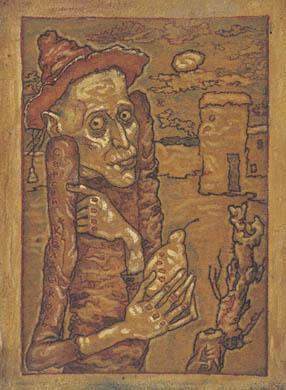
Whenever he could he would change
this decoration, although never abandoning the
overall decorative stylistics of
his dress. This is how he was portrayed by the late
Yuri Dombrovskii (in his novel
The College of Unnecessary Things): “The sun was
setting. The artist was in a hurry.
He was wearing a beret of burning colors, dark blue
trousers with stripes and a green
mantilla with bows. At his side hung a tambourine
embroidered in smoke and fire.
He didn’t dress this way for his own pleasure and
content, or for the people around
him, but for space, Mars, Mercury, for he was “the
first rate genius of the Earth
and of the Universe, decorator and performer at the Abay
Opera and Ballet Theatre, Sergey
Ivanovich Kalmykov”, as he used to call himself.
You would agree that such a figure
would not fit in with the stock image of the ordinary
Soviet worker, “a committed soldier
fighting for the victory of communism”. Had he
made for himself a capitalist type
checked jacket and cowboy boots with high heels,
he would probably have had to face
administrative measures, even to the point of
being taken into custody. But somehow
it never occurred to anyone to arrest a
“first-rate genius” of the streets
with his easel”.
“He would work day and night”, continues
Dombrovskii, “and not for his
contemporaries, but for future
generations. He didn’t care about the 21st century, he
would work for the 22nd century.
He would produce his grandiose cycles, hundreds
of canvases and sketches in each,
for those remote descendants… He did not show
anything to anyone, perhaps he
just did not have time”.
Neither did he sell his works to
anyone; sometimes he would give them as presents to
people he thought pleasant, but
never sold them. Poverty in his everyday life followed
him closely; he knew undernourishment
and starvation. Every year milk and bread
were his main food. The furniture
in his hovel was made up of packs of old
newspapers tied up with string.
Sure of his destiny, Kalmykov wrote not without
irony:
“One should not be afraid of geniuses.
They are nice people. I can judge by myself.
I am a genius myself. I have no
superiority complex. I am very modest and poor.
Ordinary people in all probability
imagine a genius in the following way: High salaries.
Popularity. Growing fame. All having
manuscripts, money. Each nursing his wealth.
But we modest professional geniuses
know: A genius means torn trousers. It means
socks with holes. It means a worn
out coat…”
Before his death in a hospital ward
he would marvel at the taste of hot food.
Sergey Kalmykov belonged to the
masters of the Silver Age of Russian Culture and
was probably the only one of them
who survived till the late 70s, nearly till our own
time. He was a contemporary of
Malevich and Kandinsky, Shagal and Filonov.
In 1910 he entered Zvantseva’s
school in Petersburg where he attended classes
conducted by Mstislav Dobuzhinsky
and Kuzma Petrov-Vodkin. After a year of
study Kalmykov produced the picture
Red Horses Bathing. Petrov-Vodkin highly
praised this work of his disciple:
“Kalmykov was like a young Japanese who had just
learned to draw”. Well, and the
“young Japanese” held his “Red horses” in high
esteem… About a year later Kuzma
Petrov-Vodkin showed his famous work The
Bathing of the Red Horse, that
in a certain sense became a symbol of the Russian
avant-garde along with the Black
Square by Malevich.
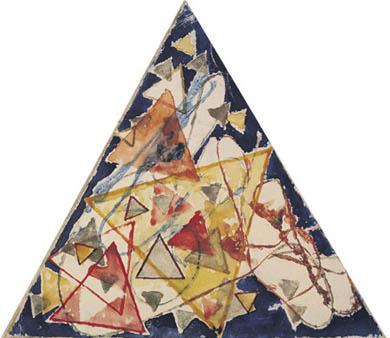 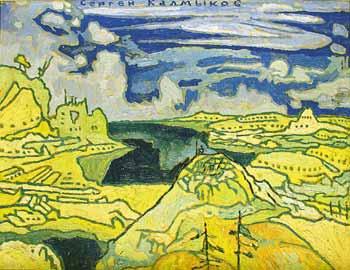
Kalmykov used to chafe: “For the
information of the future compilers of my
monograph, it was me whom our dearest
Kuzma Sergeevich depicted riding this red
horse! Yes, yes! The soulful boy
depicted on this banner represents no less a person
than me”.
In 1918 he left Petrograd and moved
to Orenburg where he had spent his childhood.
Kalmykov was convinced that the
roots of world art go back not to Paris but to
Babylon and therefore his place
of permanent residence seemed to him to be of no
particular significance. The scurry
and scramble of life in the capitals would irritate
rather than attract him. Besides,
it was a tumultuous time… Kalmykov was right: had
he stayed in Petersburg or in Moscow
he would hardly have been able to live till old
age, outliving his famous contemporaries
by a full quarter of a century.
According to very rough estimates,
Kalmykov left a legacy of over one thousand five
hundred works—drawings, prints,
paintings—and nearly ten thousand pages of
manuscripts, that look like a kind
of self-publication: sewn, collated and bound books
that were lavishly illustrated.
All of these texts without exception were made by hand;
every letter a drawing, every page
presents a complete composition. It included
essays, art critical works, philosophical
speculations and novels. The Pigeon Book,
The Green Book, The Factory of
Booms, The Moon Jazz, A Thousand Compositions
with Atomic Reflectors. He was
concerned about the future and the past, about
Space and the Atom, about Peace
and War. He wrote: “The war with the Japanese
and afterwards admiration of Japan.
Admiration for the Germans and afterwards war
with Germany. Fluctuations are
going on not only in me. And now, too. Russia is
between the East and the West,
between Europe and Asia, between the past and the
future”.
And yet, Kalmykov was closer to
the future than to the past with its Babylonian
cultural roots. Working in different
genres of Fine Art he still preferred expressive
graphical compositions and monofigure
painting to the descriptive city landscape.
Under the famous “mosaic sky” realistic
details were presented against a fanciful,
unreal background. He did not ignore
abstract compositions: for a long time his
famous Suprematist composition
was ascribed to Malevich, and later on to
Chashechnik; only recently the
efforts of dedicated researchers have yielded
documents proving Kalmykov's authorship.
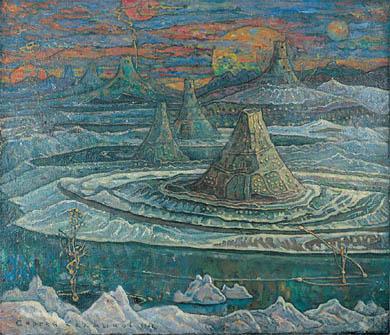
In his famous abstract triangular
paintings Sergey Kalmykov is in a state of a dialogue
not with Kazimir Malevich but with
Vasily Kandinsky. Kalmykov opposed The Theory
of a Square to The Theory of a
Point, which in his opinion was the basic dominant
element of Fine Art. Kandinsky
is close to him not only in his painting but also in his
consideration of the importance
of the musical pause, which is the equivalent of a point
in a musical work.
Kalmykov drew brilliantly and produced
about thirty self-portraits during his lifetime.
The last, made two months before
his death, was completed in the “Monster style”
he invented. The gallery of self-portraits
up until outlines the whole life of the master,
and by its level and emotionality,
is probably comparable with the artistic achievement
of aVan Gogh.
Sergey Kalmykov lived in a terrible,
surrealistic epoch, when people believed that
black was white, that Dzhugashvili
(Stalin) was the best friend of children and an
authority in all sciences, that
communism would be established by the 80s of the last
century and all citizens would
be absolutely happy and content. Kalmykov perceived
life as it really was: impenetrably
grey with stains of blood. Thus he wrote: “Just imagine
that millions of eyes are watching
you from the depths of the Universe: what would they
see? A colorless dull and gray
mass creeping on the ground and suddenly, with the
effect of a sudden shot a bright-colored
spot. That is me stepping out into the street”.
Sergey Ivanovich Kalmykov thought
he would live at least a hundred years. He died
at 76 years of age. Nobody knows
where his final resting place is.
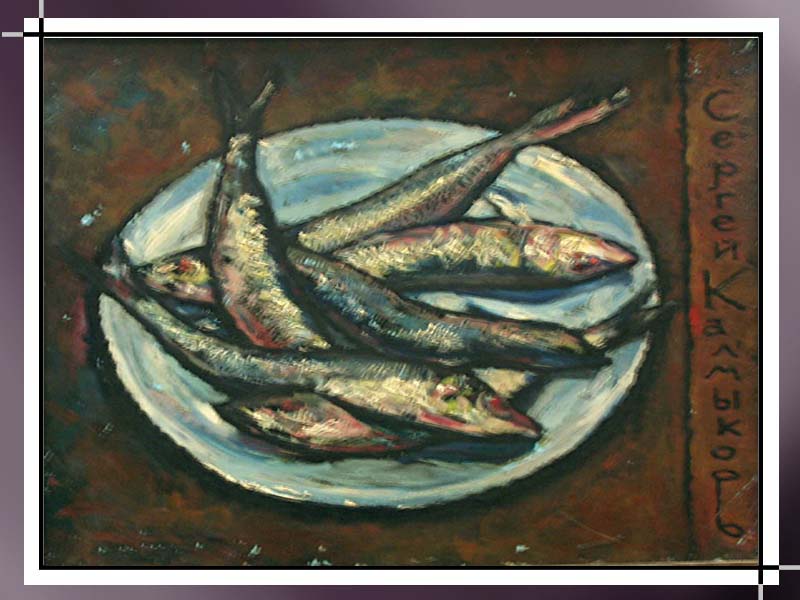
|
![]() © 2003-2011 Ars Interpres Publications.
© 2003-2011 Ars Interpres Publications.